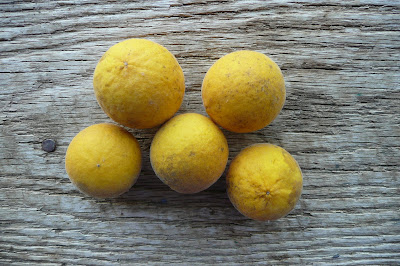Our farm has a ways to go before it can compare with the world famous Biltmore Estate. But we both have an Osage Orange.
It was probably fifteen years ago that I was visiting the Estate with a friend and, while wandering through the extensive gardens, picked up a strange orange fruit from beneath a thorny shrub-like tree. Or tree-like shrub. The sign said Osage Orange and, as there were plenty of these fruits rotting on the ground and Mr. Vanderbilt was nowhere in sight, I put the sweet-smelling thing into my pocket.
Some days later, I remembered it and laid it on the bench in the greenhouse to let it ripen. When it became rather mushy, I extracted some seeds, put them in a pot of dirt and pretty much ignored it. The pot got watered when everything else did but for half a year or longer, nothing happened.
When finally a green shoot emerged, I was thrilled. A free plant! From the Biltmore Estate yet!
The Osage Orange lived in a series of ever larger pots for about five years till it became obvious it needed room to expand. When I planted it among other shrubs and trees down near our pond, it was maybe a yard high.
Now it towers above me -- twenty feet tall and almost as wide. Its wicked thorns prevent us from doing much pruning. But I like it. This spring it was covered with sweet-smelling white blossoms and now! now it's awash in golden fruit.

Somewhere between the size of a tennis ball and a golf ball, the fruits feel velvety and are oddly fragrant. They're not edible, except for the seeds, according to one source, but they may repel fleas.
The plant has a fascinating history, including the fact that its wood was used by the Osage Indians for bows -- hence the name given it by French explorers -- bois d'arc -- bow wood. Or bodark as it's known where it grows wild.
My particular plant has its own claim to fame -- my daughter-in-law Aileen, who is an art director at White Wolf Games Studio, used a picture of its thorny branches as the background for the cover of the award-winning Changeling: The Lost. Immortality!
The plant has a fascinating history, including the fact that its wood was used by the Osage Indians for bows -- hence the name given it by French explorers -- bois d'arc -- bow wood. Or bodark as it's known where it grows wild.
My particular plant has its own claim to fame -- my daughter-in-law Aileen, who is an art director at White Wolf Games Studio, used a picture of its thorny branches as the background for the cover of the award-winning Changeling: The Lost. Immortality!




4 comments:
I love how you got your Osage Orange tree! How cool is that? They flourish around here, although, of course with 'progress' they are slowly being thinned out. (There is even a town called Bois D'Arc near here) We call them 'hedge apples' and the oldtimers (and a few smart 'new timers') used trunks of the trees and branches for fence posts--they last forever. However most of them are quite twisted, so sometimes you see a pretty bizarre looking fence row. I've also heard that the fruit repels cock roaches as well, but I have no idea if it's true. Your 'fruit' looks a little yellower than the ones I see around here. I wonder if there are different varieties? Tammy
Vicki - farmers in Illinois used to use Osage orange trees to mark their property and to keep their cattle on their own land - they grow so thick and thorny that they make a great barrier. Our nearby forest preserve has a large row on them in the woods - I like to collect them and put them in a basket for decoration - outside by the front door - they will last a long time outside - but as you know turn to mush in the house. Believe it or not they have websites where people sell them. In Illinois ours are a greenish/yellow - yours are a lovely orange. Thanks for sharing.
I have a few in a bowl in the living room and I'm loving the smell! But I'll go get a basketful for the front porch! Great idea!
I'll have to look into this for my mother-in-law in Georgia...see if they really repel roaches. Those things are everywhere down there.
Post a Comment